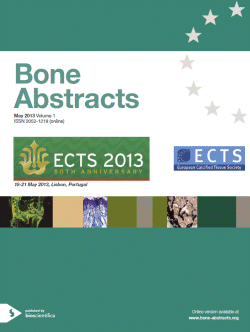
European Calcified Tissue Society Congress 2013
Lisbon,
Portugal
18 May 2013 - 22 May 2013

Poster Presentations
Genetics
ba0001pp267 | Genetics | ECTS2013
A genetic determinant of vitamin D and its role in prostate cancer
Trummer Olivia , Thurner Eva , Langsenlehner Tanja , Langsenlehner Uwe , Krenn-Pilko Sabine , Marz Winfried , Pieber Thomas , Obermayer-Pietsch Barbara , Renner Wilfried
ba0001pp268 | Genetics | ECTS2013
No mutations in the serotonin related TPH1 and HTR1B genes in patients with monogenic sclerosing bone disorders
Boudin Eveline , Jennes Karen , de Freitas Fenna , Tegay David , Mortier Geert , Van Hul Wim
ba0001pp269 | Genetics | ECTS2013
Expression analysis of mesenchymal KS483 cells during differentiation towards osteoblasts
Fijalkowski Igor , Boudin Eveline , Borra Vere , Van Hul Wim
ba0001pp270 | Genetics | ECTS2013
SQSTM1/P392L post-zygotic mutations in unrelated patients with Paget's disease of bone
Guay-Belanger Sabrina , Gagnon Edith , Morissette Jean , Brown Jacques P , Michou Laetitia
ba0001pp271 | Genetics | ECTS2013
A familial case of osteogenesis imperfecta: study of genotype-phenotype correlation.
Mihalich Alessandra , Ponti Emanuela , Broggi Francesca , Di Blasio Anna Maria , Bianchi Maria Luisa
ba0001pp272 | Genetics | ECTS2013
Comparison of gene expression in osteoblasts from patients of Polynesian and Caucasian ethnicities
Naot Dorit , Bava Usha , Choi Ally , Callon Karen , Pitto Rocco , Bentley Jarome , Gamble Greg , Cornish Jillian
ba0001pp273 | Genetics | ECTS2013
Functional analysis of the two Runx3 promoters in osseous and non-osseous cells: implications for tissue/differentiation specific transcription of distinct isoforms
Conceicao Natercia , Simoes Brigite , Cancela M Leonor
ba0001pp274 | Genetics | ECTS2013
Association between polymorphisms in leptin, its receptor and β adrenergic receptors genes and bone mineral density in postmenopausal Korean women
Kim Hoon , Ku Seung-Yup , Kim Seok Hyun , Choi Young Min , Kim Jong Hak , Kim Jung Gu
ba0001pp275 | Genetics | ECTS2013
Genetic aspects of bone remodeling disturbance in patients with aggressive periodontitis
Zinovyeva Anastasia , Atrushkevich Victoria , Polyakov Alexander
ba0001pp276 | Genetics | ECTS2013
No association between the CYP1B1/Leu432Val polymorphism and osteoporosis-related traits in Slovak postmenopausal women
Omelka Radoslav , Krajcovicova Vladimira , Spankova Jana , Durisova Jana , Martiniakova Monika , Galbavy Drahomir , Bauerova Maria
ba0001pp277 | Genetics | ECTS2013
A genomic and transcriptomic approach to the high bone mass phenotype: evidences of heterogeneity and of additive effects of TWIST1, IL6R, DLX3, and PPARG
Sarrion Patricia , Mellibovsky Leonardo , Urreizti Roser , Civit Sergi , Cols Neus , Garcia-Giralt Natalia , Yoskovitz Guy , Aranguren Alvaro , Malouf Jorge , del Rio Luis , Guerri Roberto , Nogues Xavier , Diez-Perez Adolfo , Grinberg Daniel , Balcells Susana
ba0001pp278 | Genetics | ECTS2013
Gene-wide association study of RANK and RANKL genes in the bone context: functional study of BMD-associated SNPs
Garcia-Giralt Natalia , Yoskovitz Guy , Rodriguez-Sanz Maria , Urreizti Roser , Guerri Roberto , Arino-Ballester Sergi , Prieto-Alhambra Daniel , Mellibovsky Leonardo , Grinberg Daniel , Nogues Xavier , Balcells Susana , Diez-Perez Adolfo
ba0001pp279 | Genetics | ECTS2013
Genome-wide association study meta-analysis identifies the SOAT1/AXDND1 locus to be associated with hip and forearm fracture risk
Pettersson-Kymmer Ulrika , Lacroix Andrea , Eriksson Joel , Bergstrom Ulrica , Melin Beatrice , Wibom Carl , Vandenput Liesbeth , Rajaraman Preetha , Hartge Patricia , Chanock Stephen , Hallmans Goran , Duggan David , Kooperberg Charles , Handelman Samuel , Aragaki Aaron , Nethander Maria , Uitterlinden Andre , Rivadeneira Fernando , Jackson Rebecca , Ohlsson Claes
ba0001pp280 | Genetics | ECTS2013
Association between dentinogenesis imperfecta and mutations in COLIA1 and COLIA2 genes
Andersson Kristofer , Dahllof Goran , Astrom Eva , Rubin C-J , Kindmark A , Lindahl Katarina , Ljunggren Osten , Malmgren Barbro
ba0001pp281 | Genetics | ECTS2013
Role of the functional Toll-like receptor-3 promoter polymorphism in the increased risk of osteoarthritis
ba0001pp282 | Genetics | ECTS2013
Phenotypic dissection of bone mineral density facilitates the identification of skeletal site specificity on the genetic regulation of bone
Kemp John P , Medina-Gomez Carolina , Estrada Karol , Heppe Denise , Zillikens Carola , Timpson Nicholas , Pourcain Beate , Ring Susan , Hofman Albert , Jaddoe Vincent V W , Smith George Davey , Uitterlinden Andre G , Tobias Jonathan H , Rivadeneira Fernando , Evans David M
ba0001pp283 | Genetics | ECTS2013
Discovery and replication of several loci significantly associated with lean body mass: a large meta-analysis of genome wide association studies (GWAS) from the ‘charge’ and ‘gefos’ consortia
Kiel Douglas P , Yerges-Armstrong Laura M , Hsu Yi-Hsiang , Stolk Lisette , Karasik David , Loos Ruth J F , Gudnason Vilmundar , Smith Albert , O'Connell Jeffrey R , Fu Amish , Fu Mao , Streeten Elizabeth A , Cauley Jane A , Robbins John A , Psaty Bruce , Johnson Toby , Kutalik Zoltan , Mitchell Braxton D , Livshits Gregory , Harris Tamara B , Ohlsson Claes , Zillikens M Carola



